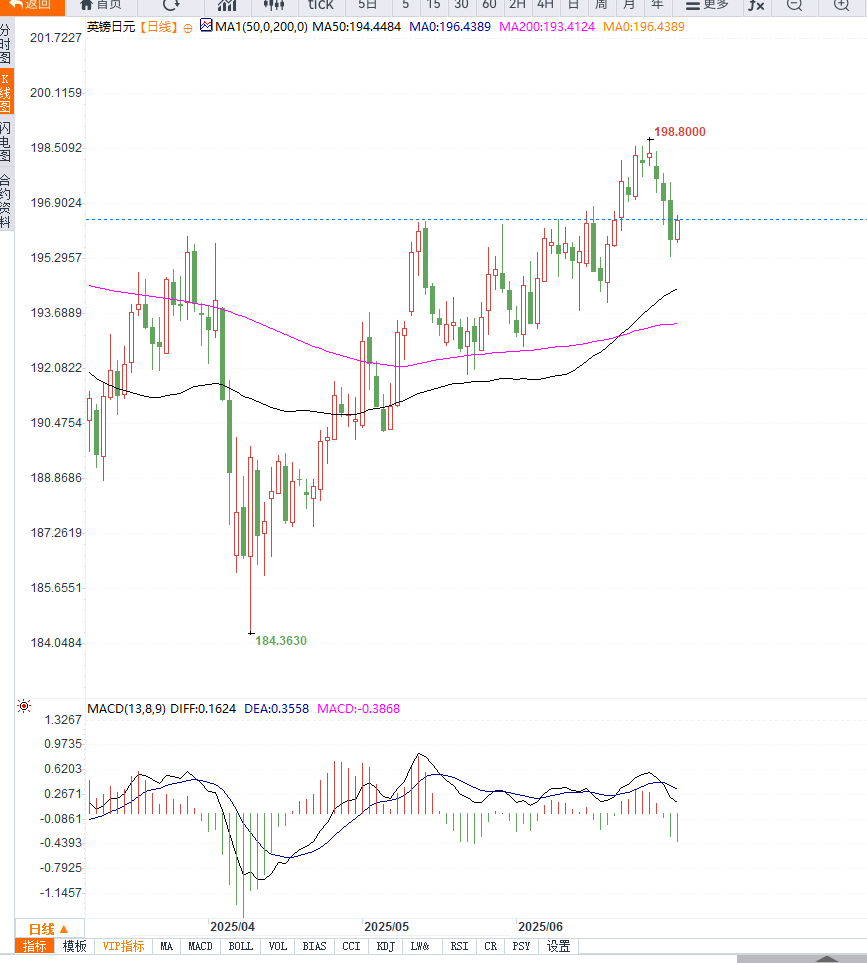British fiscal concerns and expectations of five interest rate cuts weighed heavily on the pound, GBP/JPY fell below the 196 mark, and there is still a risk of a correction in the short term
2025-07-03 15:44:07
The 10-year UK government bond yield surged nearly 4% to 4.61% on Wednesday, one of the biggest one-day increases in recent years. This trend occurred after Finance Minister Reeves submitted a new welfare bill to Parliament, which was criticized by the Conservative Party as a departure from the commitment to fiscal austerity and would further expand the UK deficit.
"This is not just a sell-off in sterling, but a warning sign for confidence in the entire UK bond market," said Marc Chandler, a UK currency strategist.

There were market rumors that the Chancellor of the Exchequer might resign due to political pressure. Although Prime Minister Starmer subsequently came out to support him, the market's risk aversion sentiment did not subside.
On the other hand, the pound was also weighed down by the shift in monetary policy. Alan Taylor, a member of the Bank of England's Monetary Policy Committee (MPC), said at the European Central Bank's annual meeting that he expected the UK to cut interest rates as many as five times this year, and the base rate could fall to between 2.75% and 3.00% by the end of the year, much lower than the current level.
This signal of a hawkish-to-dovish shift directly offsets the UK's previous expectations of high inflation and poses a substantial negative impact on the pound.
Data showed that the pound was weak against most major currencies this week, falling 1.4% against the Swiss franc (CHF), 1.06% against the yen and 0.61% against the dollar.
As for the yen, the Bank of Japan continued to send hawkish signals. Hajime Takata, a member of the Bank of Japan's board of directors, said on Wednesday that it was necessary to "flexibly respond to the impact of US tariffs" and hinted that if external inflation continued to be transmitted to the domestic market, it would consider resuming the interest rate hike process. This allowed the yen to continue to receive capital inflows in an environment where global risk sentiment has slightly warmed up.
The current Japanese yen has the dual bullish basis of low valuation and expectations of policy shift, making it more advantageous in the short term to counter downward pressure on the pound.
On the daily chart, GBP/JPY shows obvious signs of correction. The exchange rate has closed negative for three consecutive trading days and fell below the key support level of 197.00. It is currently fluctuating and consolidating at 196.00. Technically, the 14-day relative strength index (RSI) has fallen below 45, and the momentum indicator (MACD) has formed a dead cross, indicating that the short-term momentum has increased.
The exchange rate is currently running below the 20-day and 50-day moving averages, and the K-line has fallen below the rising trend line support, indicating that the upward trend has come to a temporary end. The initial support below is at 195.40 (this week's low) and 193.80 (the lower edge of the mid-May oscillation range). If it fails, it may trigger further selling pressure and test the 192.50 or even 190.00 mark.
The upper resistance is 196.80~197.30 (the previous dense trading zone and the 20-day moving average retracement position). If it fails to return to the upper part of this area, the exchange rate may maintain a weak shock structure and continue to adjust. Overall, the daily chart structure has weakened, and GBP/JPY will maintain a high downside risk in the short term.

Editor's opinion:
GBP/JPY is currently at the intersection of "GBP systemic risk exposure" and "JPY policy returning to normal". With British bond yields out of control, fiscal policy uncertain, and the Federal Reserve and the Bank of England both likely to cut interest rates this year, the medium-term outlook for the pound is not optimistic.
The Japanese yen has the dual support of rising long-term interest rates and continued inflation. It is expected that the exchange rate will continue to be under pressure and may fall to the 193.80 area in the future. Wait for the UK's political situation and fiscal route to become more clear before considering the rebound opportunity.
- Risk Warning and Disclaimer
- The market involves risk, and trading may not be suitable for all investors. This article is for reference only and does not constitute personal investment advice, nor does it take into account certain users’ specific investment objectives, financial situation, or other needs. Any investment decisions made based on this information are at your own risk.










